Permaculture companion plants for Squash
| Image | Name | Data | Description | Actions |
|---|---|---|---|---|

|
Zea mays |
2-11
Full sun
Moist
Light (sandy), Medium, Heavy (clay)
2
0.66
Annual
Fast
true
Pollen, Seed, Stem
Oil, Coffee
Maize, corn, abado, able, aburow, agbado, awasi, awi, bara-jowar, bhutta, blefo, bli, buta, chujak, goinjol, gomdhan, igbado, jagung, janar, jonar, junri, kaaba, keto, kolkoti, kon, kono, kukri, maka, makai, makka jonnalu, makka-cholam, makka, makkai, makkari, makoi, masara agwado, massara, mekkejola, milho, mokka-janna, musukojola, naham, nyo, oka, oksusu, shaa, sil ni vavalagi, ta-mank, yu shu shu, ai, amylum maydis, awási, aya, corn oi, 6 corn oil (unhydrogenated), corn silk, corn starch, corn syrup solids, corn|iringu, dent corn, dura shami, field corn, flint corn, gangnaengi, granoturco, indian corn, maidis stigma, mais, maiz, aceite, maize oil, refined, maize starch, majs, maydis amylum, maydis oleum raffinatum, maydis stigma, maíz, aceite refinado, maîs, maïs, ogsusu, oleum maydis, pelos de elafe, pod corn, popcorn, refined maize oil, risoy genime sami, stigmata maidis, styli cum stigmatis zeae maydis, sweet corn, topical starch, to-morokoshi, yu mi shu, yu mi xu, zein, zorrat
Mais
Poaceae or gramineae
Guatemala, Mexico Central, Mexico Southwest
Afghanistan, Alabama, Albania, Aldabra, Algeria, Amur, Andaman Is., Angola, Argentina Northeast, Arizona, Arkansas, Aruba, Assam, Austria, Azores, Bahamas, Baleares, Baltic States, Bangladesh, Belarus, Belgium, Belize, Benin, Bismarck Archipelago, Bolivia, Borneo, Brazil North, Brazil Northeast, Brazil South, Brazil Southeast, Brazil West-Central, Bulgaria, Burkina, Burundi, California, Cambodia, Cameroon, Canary Is., Caroline Is., Cayman Is., Central African Repu, Central European Rus, Chad, Chagos Archipelago, China North-Central, China South-Central, China Southeast, Christmas I., Colombia, Colorado, Comoros, Connecticut, Corse, Costa Rica, Cuba, Cyprus, Czechoslovakia, Djibouti, Dominican Republic, East European Russia, East Himalaya, Ecuador, Egypt, Equatorial Guinea, Ethiopia, Fiji, Florida, France, French Guiana, Galápagos, Gambia, Georgia, Germany, Ghana, Great Britain, Greece, Guinea, Guinea-Bissau, Gulf of Guinea Is., Hainan, Haiti, Hawaii, Honduras, Hungary, Idaho, Illinois, India, Indiana, Iowa, Iraq, Ireland, Italy, Ivory Coast, Jamaica, Japan, Jawa, Kansas, Kazakhstan, Kentucky, Khabarovsk, Kirgizstan, Korea, Kriti, Krym, Laos, Leeward Is., Lesser Sunda Is., Louisiana, Madagascar, Maine, Malaya, Mali, Maluku, Manchuria, Marianas, Marshall Is., Maryland, Massachusetts, Mauritius, Mexico Gulf, Mexico Northeast, Mexico Northwest, Mexico Southeast, Minnesota, Mississippi, Missouri, Montana, Morocco, Mozambique, Myanmar, Nansei-shoto, Nebraska, Nepal, Netherlands, Netherlands Antilles, Nevada, New Caledonia, New Guinea, New Hampshire, New Jersey, New Mexico, New York, Nicaragua, Niger, Nigeria, Niue, North Carolina, North Caucasus, Northwest European R, Ohio, Oman, Ontario, Oregon, Pakistan, Panamá, Pennsylvania, Peru, Philippines, Pitcairn Is., Poland, Portugal, Primorye, Puerto Rico, Queensland, Québec, Rhode I., Rodrigues, Romania, Rwanda, Réunion, Sakhalin, Samoa, Sardegna, Seychelles, Sicilia, Sierra Leone, Somalia, South Carolina, South European Russi, Spain, Sri Lanka, Sudan, Switzerland, Tadzhikistan, Tanzania, Tennessee, Texas, Thailand, Togo, Transcaucasus, Trinidad-Tobago, Tunisia, Turkey, Turkey-in-Europe, Turkmenistan, Ukraine, Uruguay, Utah, Uzbekistan, Vanuatu, Venezuelan Antilles, Vermont, Vietnam, Virginia, Wake I., Washington, West Himalaya, West Virginia, Western Australia, Windward Is., Wisconsin, Wyoming, Yemen, Yugoslavia, Zambia, Zaïre
https://en.wikipedia.org/wiki/Maize
https://pfaf.org/User/Plant.aspx?LatinName=Zea mays
https://powo.science.kew.org/taxon/urn:lsid:ipni.org:names:426810-1
Adhesive, Fire starter, oil, textiles
|
Corn (Zea mays) is a plant native to Central America and Mexico. It is a tall plant with a sturdy stem and large leaves that grow in a spiral pattern around the stem. The plant produces large, brightly colored flowers that give way to ears of corn. The ears are typically yellow, but can also be white, red, or blue. Corn grows to be anywhere from 3-12 feet tall and can grow quickly, depending on the variety. To differentiate corn from similar plants, gardeners and farmers can look for the spiral pattern of the leaves and the presence of ears. Corn is often grown in rows, which can also help to distinguish it from other plants. Corn prefers well-draining, fertile soil and full sun. In order to cultivate it successfully, a grower will need to provide these conditions and also ensure that the plants receive adequate water. Corn is often grown from seed, which should be planted in the ground when the soil has warmed to at least 60 degrees Fahrenheit. Corn is edible, and the edible parts are the kernels that are found on the ears. The ears can be harvested when the kernels are plump and fully developed. They can be stored after harvest by drying them in the sun or by freezing them. Corn has many uses. In addition to being a popular food crop, it can also be used as livestock feed and as a source of biofuel. It can also be used as a building material and for crafting. Corn has medicinal properties and has been used to treat a variety of ailments. It is also valued by wildlife, as it provides food and shelter for birds, small mammals, and insects. |
Show
Edit |

|
Marjoram |
6-9
Perennial
Full sun, Partial sun/shade
Dry, Moist
Light (sandy), Medium, Heavy (clay)
0.6
Herbs
true
Leaves
https://en.wikipedia.org/wiki/Marjoram
Lamiaceae or labiatae
Majoran
https://pfaf.org/User/Plant.aspx?LatinName=Origanum majorana
Cyprus, Turkey
Algeria, Azores, Baleares, Baltic States, Corse, Czechoslovakia, Great Britain, Greece, India, Italy, Juan Fernández Is., Krym, Libya, Madeira, Morocco, Spain, Switzerland, Tunisia, Ukraine, Venezuela, Yugoslavia
https://powo.science.kew.org/taxon/urn:lsid:ipni.org:names:453303-1
Condiment, Tea
Disinfectant, Dye, Essential Oil, Fragrance
|
Marjoram (Origanum majorana) is a herbaceous plant that is native to the Mediterranean region. It has delicate, oval-shaped leaves that are pale green in color, and small white or pink flowers that grow in clusters. The plant grows to a height of about 30 cm and has a woody stem. In terms of growing conditions, marjoram prefers well-drained, light soil and full sun to partial shade. It can be grown from seeds or cuttings, and should be spaced about 30 cm apart. Marjoram is winter hardy in mild climates, but may need to be protected or brought indoors in colder regions. Marjoram has a number of culinary uses. It is often used as a flavoring in soups, stews, and sauces, and can be added to salads and other dishes as a garnish. The leaves and flowers of the plant are edible and can be used fresh or dried. When harvesting marjoram, it is best to pick the leaves early in the morning when they are at their most flavorful. The leaves can be stored in an airtight container in a cool, dark place for up to six months. In addition to its culinary uses, marjoram has also been used medicinally as an antiseptic and as a remedy for digestive problems. It is also sometimes used in perfumes and soaps. Marjoram is not particularly attractive to wildlife, but it can provide habitat for some beneficial insects such as bees and butterflies. |
Show
Edit |
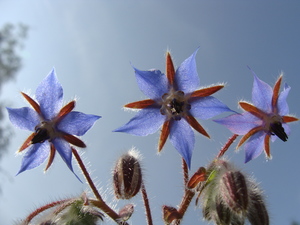
|
Borage |
6-9
Annual
Full sun, Partial sun/shade
Dry, Moist
Light (sandy), Medium, Heavy (clay)
0.6
Herbs
Flowers, Leaves
Seed - direct sow
https://en.wikipedia.org/wiki/Borage
Medium
Common borage, Cool-tankard, Tailwort, Starflower
Boraginaceae
Borretsch
60cm
5-15 days
21°c (70°f)
Oil, Colouring, Tea
https://pfaf.org/User/Plant.aspx?LatinName=Borago officinalis
Borago
5
-2
Algeria, Baleares, Corse, France, Greece, Italy, Kriti, Libya, Morocco, Portugal, Sardegna, Sicilia, Spain, Tunisia, Yugoslavia
Alaska, Alberta, Altay, Argentina Northeast, Argentina Northwest, Argentina South, Austria, Azores, Baltic States, Belgium, Bolivia, British Columbia, Buryatiya, California, Canary Is., Central European Rus, Chile Central, Colombia, Connecticut, Cuba, Cyprus, Czechoslovakia, District of Columbia, Dominican Republic, East Aegean Is., East European Russia, Ecuador, Germany, Great Britain, Guatemala, Haiti, Honduras, Hungary, Illinois, Irkutsk, Jawa, Kamchatka, Kazakhstan, Kirgizstan, Krym, Kuril Is., Lebanon-Syria, Madeira, Maine, Manitoba, Massachusetts, Mexico Central, Mexico Southwest, Michigan, Minnesota, Montana, Netherlands, New Brunswick, New Hampshire, New Jersey, New York, New Zealand North, New Zealand South, Newfoundland, North Caucasus, North Dakota, North European Russi, Northwest European R, Nova Scotia, Ohio, Ontario, Oregon, Pennsylvania, Peru, Poland, Primorye, Prince Edward I., Puerto Rico, Québec, Rhode I., Romania, Sakhalin, Saskatchewan, South European Russi, Switzerland, Tasmania, Tubuai Is., Turkey, Turkey-in-Europe, Turkmenistan, Ukraine, Uruguay, Utah, Vermont, Virginia, Washington, West Siberia, West Virginia, Wisconsin
At last frost
0.3
https://powo.science.kew.org/taxon/urn:lsid:ipni.org:names:113618-1
Dye, oil, Dynamic accumulator
true
|
Borage, also known as Borago officinalis, is a herb native to the Mediterranean region. It is a hairy, annual herb that grows to a height of about 60 cm, with blue, star-shaped flowers and large hairy leaves. The plant is easily differentiated from similar plants by its hairy stems and leaves, and its bright blue flowers. Borage prefers well-drained soil and full sun, and grows best in warm temperatures. It is a fast-growing plant, and can be easily cultivated by direct sowing or transplanting seedlings. Borage is not winter hardy, and should be grown as an annual in most climates. The leaves and flowers of borage are edible, and can be used in salads, soups, and other dishes. The leaves have a cucumber-like flavor, while the flowers are slightly sweet. The edible parts of the plant can be stored by freezing or drying. Borage has several medicinal uses, and has been used traditionally to treat a variety of ailments, including respiratory problems, skin irritation, and anxiety. It is also a good source of nutrients, including calcium, potassium, and vitamin C. In addition to its medicinal uses, borage has value as a companion plant in the garden. It attracts pollinators, such as bees and butterflies, and can be used as a natural pest deterrent. #### Propagation Direct sow early spring when temperatures reach 21°C (70°F). Best sown directly, as borage develops a delicate taproot. #### Links [Borage @ West Coast Seeds](https://www.westcoastseeds.com/products/borage) |
Show
Edit |
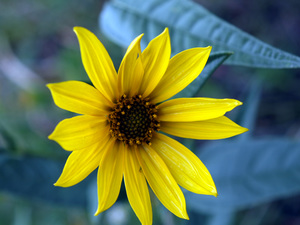
|
Maximilian Sunflower |
4-10
Full sun
Moist
Light (sandy), Medium, Heavy (clay)
2.4
1.3
Perennial
Medium
true
Root
Maximillian daisy
Asteraceae or compositae
Alabama, Alberta, Arkansas, British Columbia, California, Colorado, Connecticut, Delaware, District of Columbia, Idaho, Illinois, Indiana, Iowa, Kansas, Kentucky, Maine, Manitoba, Maryland, Massachusetts, Mexico Northeast, Michigan, Minnesota, Mississippi, Missouri, Nebraska, New Jersey, New York, North Carolina, North Dakota, Ohio, Oklahoma, Ontario, Pennsylvania, Québec, Saskatchewan, South Carolina, South Dakota, Tennessee, Texas, Utah, Virginia, Washington, West Virginia, Wisconsin, Wyoming
https://en.wikipedia.org/wiki/Helianthus_maximiliani
https://powo.science.kew.org/taxon/urn:lsid:ipni.org:names:329260-2
|
#### Links [Maximilian Sunflower @ Plants For A Future](https://pfaf.org/user/Plant.aspx?LatinName=Helianthus maximilianii) |
Show
Edit |

|
Common Sunflower |
https://en.wikipedia.org/wiki/Helianthus_annuus
true
Fast
Dry, Moist
Full sun, Partial sun/shade
6-9
Common sunflower
Light (sandy), Medium, Heavy (clay)
Asteraceae or compositae
3.0
Flowers, Seed, Stem
Oil, Coffee
Weed potential
Annual
https://pfaf.org/User/Plant.aspx?LatinName=Helianthus annuus
Arizona, California, Mexico Central, Mexico Northeast, Mexico Northwest, Mexico Southwest, Nevada
Alabama, Alaska, Albania, Alberta, Altay, Amur, Argentina Northeast, Argentina Northwest, Argentina South, Arkansas, Assam, Austria, Azores, Baltic States, Bangladesh, Belarus, Belgium, Belize, Bolivia, Botswana, British Columbia, Bulgaria, Buryatiya, Cape Provinces, Caprivi Strip, Central European Rus, Chile Central, Chile North, Chile South, China North-Central, China South-Central, China Southeast, Chita, Colombia, Colorado, Connecticut, Corse, Costa Rica, Delaware, Denmark, District of Columbia, Dominican Republic, East European Russia, East Himalaya, El Salvador, Finland, Florida, France, Free State, Georgia, Germany, Great Britain, Greece, Guatemala, Hainan, Haiti, Honduras, Hungary, Idaho, Illinois, India, Indiana, Inner Mongolia, Iowa, Ireland, Irkutsk, Italy, Japan, Kamchatka, Kansas, Kazakhstan, Kentucky, Khabarovsk, Kirgizstan, Korea, Krasnoyarsk, KwaZulu-Natal, Lesotho, Libya, Louisiana, Magadan, Maine, Manchuria, Manitoba, Maryland, Massachusetts, Mexico Gulf, Mexico Southeast, Michigan, Minnesota, Mississippi, Missouri, Montana, Morocco, Namibia, Nebraska, Nepal, Netherlands, New Brunswick, New Hampshire, New Jersey, New Mexico, New South Wales, New York, New Zealand North, New Zealand South, Newfoundland, North Carolina, North Caucasus, North Dakota, North European Russi, Northern Provinces, Northern Territory, Northwest Territorie, Norway, Nova Scotia, Nunavut, Ohio, Oklahoma, Ontario, Oregon, Pakistan, Palestine, Paraguay, Pennsylvania, Peru, Poland, Primorye, Prince Edward I., Qinghai, Queensland, Québec, Rhode I., Romania, Sakhalin, Sardegna, Saskatchewan, Sicilia, South Australia, South Carolina, South Dakota, South European Russi, Spain, Swaziland, Sweden, Switzerland, Tadzhikistan, Tasmania, Tennessee, Texas, Thailand, Tibet, Transcaucasus, Turkey, Turkey-in-Europe, Turkmenistan, Tuva, Ukraine, Uruguay, Utah, Uzbekistan, Vermont, Victoria, Virginia, Washington, West Himalaya, West Siberia, West Virginia, Western Australia, Wisconsin, Wyoming, Xinjiang, Yakutskiya, Yugoslavia
https://powo.science.kew.org/taxon/urn:lsid:ipni.org:names:119003-2
Blotting paper, Dye, Fiber, Fire starter, Cover crop, Herbicide, Microscope, oil, textiles, Dynamic accumulator
|
Show
Edit |
|
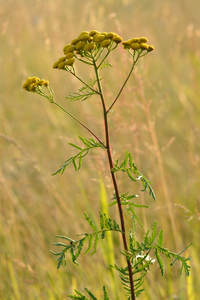
|
Tansy |
3-8
Full sun
Dry, Moist
Light (sandy), Medium, Heavy (clay)
1.0
0.5
Perennial
Herbs
Fast
true
Flowers, Leaves
Common tansy, golden buttons, curly leaf tansy
Rainfarn
Asteraceae or compositae
Albania, Altay, Amur, Austria, Baltic States, Belarus, Belgium, Bulgaria, Buryatiya, Central European Rus, Chita, Corse, Czechoslovakia, Denmark, East European Russia, Finland, France, Germany, Great Britain, Greece, Hungary, Inner Mongolia, Irkutsk, Italy, Japan, Kamchatka, Kazakhstan, Khabarovsk, Kirgizstan, Korea, Krasnoyarsk, Krym, Kuril Is., Magadan, Manchuria, Mongolia, Netherlands, North Caucasus, North European Russi, Northwest European R, Norway, Poland, Portugal, Primorye, Romania, Sakhalin, Sicilia, South European Russi, Spain, Sweden, Switzerland, Transcaucasus, Turkey, Turkey-in-Europe, Tuva, Ukraine, West Siberia, Xinjiang, Yakutskiya, Yugoslavia
Alaska, Alberta, Arizona, Arkansas, Bolivia, Brazil North, Brazil Northeast, Brazil South, Brazil Southeast, Brazil West-Central, British Columbia, California, Colombia, Colorado, Connecticut, Cook Is., Ecuador, Føroyar, Georgia, Iceland, Idaho, Illinois, Indiana, Iowa, Ireland, Kansas, Kentucky, Labrador, Louisiana, Maine, Manitoba, Maryland, Massachusetts, Mauritius, Michigan, Minnesota, Missouri, Montana, Nebraska, Nevada, New Brunswick, New Hampshire, New Jersey, New Mexico, New South Wales, New York, Newfoundland, North Carolina, North Dakota, Northwest Territorie, Nova Scotia, Ohio, Oklahoma, Ontario, Oregon, Panamá, Paraguay, Pennsylvania, Peru, Prince Edward I., Queensland, Québec, Rhode I., Réunion, Saskatchewan, South Australia, South Dakota, Tasmania, Tennessee, Trinidad-Tobago, Tubuai Is., Uruguay, Utah, Venezuela, Vermont, Victoria, Virginia, Washington, West Virginia, Wisconsin, Wyoming
https://en.wikipedia.org/wiki/Tansy
https://pfaf.org/User/Plant.aspx?LatinName=Tanacetum vulgare
https://powo.science.kew.org/taxon/urn:lsid:ipni.org:names:252568-1
0.2
Weed potential
Condiment, Tea
Compost, Dye, Essential Oil, Pest control, Strewing, Dynamic accumulator, Fragrance
|
Show
Edit |
|
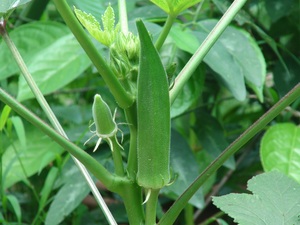
|
Abelmoschus esculentus |
5-11
Full sun
Moist
Light (sandy), Medium, Heavy (clay)
1.0
1.7
Annual, Perennial
Herbs
true
Fruit, Leaves, Root, Seed
Oil, Coffee, Pectin
A-koto, angu, apala, asowntem, bakhua-mun, bamia, bandakka, bendi, bhindee, bhindi, binda, bindi, bondo, cantarela, derere rechipudzi, derere, dheras, dherosh, enmomi, fetri, gombaut, gombo, gumbo, guro, gusha, hakuyot, idelele, ikhievbo, ilasha, ilo, ka fei huang kui, kacang bendi, kaganh lender, kandia, kandjie, kopi arab, krachiap-mon, kubewa, lafeu, lieka, loka, maana, ma-lontho, mesta, muomi, miagorro, nathando, nkruma, obori, ochro, okworu, okwulu, otigo-iwoka, pahari bendi, pingpesi, poot barang, pui, quiabo, quimbambo, saluyot a bunga, sayur bendi, taku, uisul hme, vandakai, vandikkai, vendal, wayika, you-padi
Malvaceae
Bangladesh, India, Myanmar
Alabama, Albania, Andaman Is., Angola, Assam, Bahamas, Benin, Borneo, Bulgaria, Burkina, Cambodia, Cape Verde, Caroline Is., Cayman Is., Central African Repu, Chad, China South-Central, China Southeast, Comoros, Congo, Cuba, Dominican Republic, East Himalaya, Eritrea, Fiji, Florida, Gabon, Gambia, Georgia, Greece, Guinea-Bissau, Gulf of Guinea Is., Hainan, Haiti, Illinois, Ivory Coast, Jamaica, Jawa, Krym, KwaZulu-Natal, Laos, Leeward Is., Louisiana, Malaya, Mali, Marianas, Marshall Is., Maryland, Mauritania, Mexico Southwest, Mississippi, Mozambique, Nicobar Is., Niger, Nigeria, North Carolina, Northern Provinces, Oman, Pakistan, Peru, Philippines, Puerto Rico, Romania, Senegal, Sierra Leone, South Carolina, South European Russi, Southwest Caribbean, Sri Lanka, Sudan, Tanzania, Thailand, Togo, Uganda, Ukraine, Venezuela, Venezuelan Antilles, Vietnam, Virginia, Windward Is., Zambia, Zaïre, Zimbabwe
https://en.wikipedia.org/wiki/Okra
https://pfaf.org/User/Plant.aspx?LatinName=Abelmoschus esculentus
https://powo.science.kew.org/taxon/urn:lsid:ipni.org:names:558006-1
Weed potential
Fiber, oil, textiles, Pectin
|
Show
Edit |
|
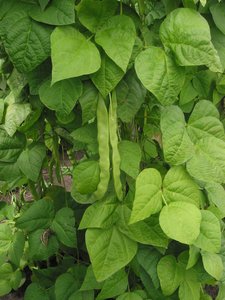
|
Common bean |
2-11
Annual
Full sun
Moist
Light (sandy), Medium, Heavy (clay)
2.0
Vines
Biomass, Dye, antifungal, Nitrogen fixer
true
Leaves, Seed, Seedpod
Seed - transplant, Seed - direct sow
https://en.wikipedia.org/wiki/Phaseolus_vulgaris
Pole bean, Climbing bean, French bean, Bush bean, Dwarf bean, Kidney bean, Green bean
Fabaceae, Leguminosae
Stangenbohne
https://pfaf.org/User/Plant.aspx?LatinName=Phaseolus vulgaris
16-18°c (70-80°f)
6.0-6.8
2.5 cm
16cm
4-10 days
45-85
Fast
Sperzieboon
Costa Rica, Guatemala, Honduras, Mexico Central, Mexico Gulf, Mexico Northeast, Mexico Northwest, Mexico Southeast, Mexico Southwest, Nicaragua, Panamá
Altay, Amur, Andaman Is., Angola, Argentina Northeast, Argentina Northwest, Assam, Baltic States, Bangladesh, Belarus, Bolivia, Bulgaria, Buryatiya, Cameroon, Cayman Is., Central European Rus, Chad, Chita, Colombia, Comoros, Cuba, Czechoslovakia, Dominican Republic, East European Russia, East Himalaya, Ecuador, Ethiopia, Guinea, Gulf of Guinea Is., Haiti, Illinois, India, Iraq, Irkutsk, Jamaica, Jawa, Kazakhstan, Kenya, Khabarovsk, Kirgizstan, Korea, Krasnoyarsk, Kuril Is., Leeward Is., Malaya, Marianas, Maryland, Mongolia, Myanmar, Nepal, New Guinea, New York, Nicobar Is., Nigeria, North Caucasus, North European Russi, Northwest European R, Pakistan, Peru, Philippines, Primorye, Puerto Rico, Queensland, Rwanda, Sakhalin, Senegal, South European Russi, Sri Lanka, Tadzhikistan, Tanzania, Thailand, Togo, Transcaucasus, Trinidad-Tobago, Turkmenistan, Tuva, Uganda, Ukraine, Uzbekistan, Venezuela, Vietnam, Wake I., West Himalaya, West Siberia, Yakutskiya, Zambia, Zaïre
2-4 weeks before last frost
1 week after last frost, 12-14 weeks before first frost
3-5 years
0.4
https://powo.science.kew.org/taxon/urn:lsid:ipni.org:names:514191-1
Coffee, Condiment
|
This entry describes all varieties of the common bean. This includes vining and bush/darf variaties and can have different names depending on their style of growths (see alternate names). These include the kidney bean, the navy bean, the pinto bean, the French bean and the wax bean The common bean, scientific name Phaseolus vulgaris, is a herbaceous annual plant native to the Americas, specifically the regions extending from the southwestern United States to South America. It is a member of the Fabaceae (legume) family. The common bean has a range of different appearances, depending on the variety. Most varieties have a simple, erect stem that grows to a height of 20-60 cm. The leaves are typically green and consist of 3-5 oblong leaflets. The flowers are small and white, pink, or purple in color. The fruit is a legume, which contains the seeds. The common bean is typically a small plant, but some varieties can grow to be quite large, reaching heights of up to 2 meters. The plant grows relatively quickly, with the growing season typically lasting between 60-100 days. The common bean prefers well-drained soil and full sun, but can also grow in partial shade. It is sensitive to frost and should be planted after the last frost date in the spring. To cultivate the common bean successfully, a grower may need to ensure that the soil is adequately fertilized and provide support for the plant to climb, if necessary. The common bean is edible, with the seeds and the young pods being the most commonly consumed parts. The seeds can be cooked and eaten as a protein-rich vegetable, and the young pods can be eaten as a green vegetable. The edible parts can be stored after harvest by drying the seeds or by preserving the young pods in vinegar or oil. The common bean has many uses beyond being a food source. The plant can fix nitrogen in the soil, improving its fertility and making it a useful companion plant for other crops. The dried leaves and stems of the common bean can be used as mulch or as a source of organic matter. In some cultures, the fibers from the stems are used to make ropes or other weaving materials. Additionally, the plant has been used medicinally to treat a variety of ailments. The common bean is also valuable for wildlife. The flowers attract bees and other pollinators, and the plant provides food for a variety of insects, birds, and small mammals. ### Links [Beans Seed Starting Tips @ Harvest to Table](https://harvesttotable.com/beans-seed-starting-tips/) ### Propagation - direct sow Direct-sow beans in spring after all danger of frost has passed and soil is at least 16°C (60°F). In warm-winter regions, sow beans in late summer for harvest in winter. Time sowing so that beans come to harvest before the first frost. |
Show
Edit |

|
Runner Bean |
1-12
Annual, Perennial
Full sun
Moist
Light (sandy), Medium, Heavy (clay)
3.0
true
Flowers, Leaves, Root, Seed, Seedpod
https://en.wikipedia.org/wiki/Phaseolus_coccineus
Fast
Scarlet runner, scarlet runner bean, scarlet conqueror, fire bean, mammoth, red giant phaseolus coccineus ssppolyanthus (cache bean)
Fabaceae or leguminosae
https://pfaf.org/User/Plant.aspx?LatinName=Phaseolus coccineus
Guatemala, Honduras, Mexico Central, Mexico Gulf, Mexico Northeast, Mexico Northwest, Mexico Southeast, Mexico Southwest, Nicaragua, Panamá
Alabama, Amur, Assam, Baltic States, Bangladesh, Belarus, Bulgaria, Central European Rus, China North-Central, China South-Central, China Southeast, Colombia, Czechoslovakia, East European Russia, East Himalaya, Ecuador, Ethiopia, India, Inner Mongolia, Jawa, Kenya, Khabarovsk, Kirgizstan, Korea, Manchuria, Nepal, New Guinea, New Zealand North, New Zealand South, North European Russi, Northwest European R, Pakistan, Primorye, Rwanda, South European Russi, Tanzania, Transcaucasus, Ukraine, Uzbekistan, Wake I., West Himalaya
3-5 years
https://powo.science.kew.org/taxon/urn:lsid:ipni.org:names:513754-1
Nitrogen fixer
|
Show
Edit |
|
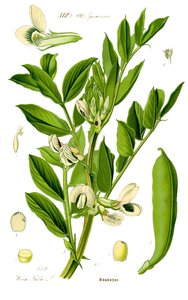
|
Broad Bean |
4-8
Full sun, Partial sun/shade
Moist
Light (sandy), Medium, Heavy (clay)
6.0-6.8
1.0
0.3
Annual
Fast
20cm
Seed - direct sow, Seed - transplant
6 weeks after sowing them in pots
6 weeks after sowing them in pots
21 days
3-5 years
Nitrogen fixer
Leaves, Seed
fava bean, faba bean, Broad bean, or faba bean Varieties with smaller, harder seeds that are fed to horses or other animals are called field bean, tic bean or tick bean Horse bean
Ackerbohne
Fabaceae or Leguminosae
Afghanistan, Iran
Albania, Algeria, Altay, Angola, Argentina South, Assam, Baleares, Bangladesh, Bolivia, Bulgaria, Cameroon, Canary Is., Central European Rus, Chad, China North-Central, China South-Central, China Southeast, Colombia, Corse, Cuba, Cyprus, Czechoslovakia, Dominican Republic, East Aegean Is., East European Russia, Ecuador, Ethiopia, France, Guatemala, India, Iraq, Italy, Jawa, Kenya, Krym, Lebanon-Syria, Leeward Is., Libya, Madeira, Mexico Southwest, Mongolia, Morocco, Myanmar, Nepal, New South Wales, New York, New Zealand North, New Zealand South, Pakistan, Peru, Portugal, Puerto Rico, Rwanda, Sardegna, Sicilia, Spain, Sri Lanka, Sudan, Tibet, Tunisia, Turkey, Turkey-in-Europe, Uruguay, Vermont, Vietnam, West Himalaya, Yemen, Yugoslavia
https://en.wikipedia.org/wiki/Vicia_faba
https://pfaf.org/User/Plant.aspx?LatinName=Vicia faba major
https://powo.science.kew.org/taxon/urn:lsid:ipni.org:names:524737-1
Feb-April; Oct-Nov
sow in deep pots in cool, frost-free place
|
Broad bean (Vicia faba), also known as fava bean or faba bean, is a type of legume that is native to North Africa and the Middle East. It is a popular garden plant, known for its edible beans and attractive purple or white flowers. Broad bean plants have a upright, bushy growth habit and can reach a height of up to 3 feet. The leaves are large and composed of three oval-shaped leaflets, and the flowers are small and clustered in groups of two or three. The beans are produced in long, slender pods that contain two or three beans each. To grow broad beans successfully, it is important to choose a location with well-drained, fertile soil and full sun. The plants should be spaced about 8-12 inches apart, and watered regularly to ensure that the soil stays moist but not waterlogged. Broad beans are generally easy to grow and require little maintenance, but they can be susceptible to pests and diseases, such as aphids and fungal infections. Grows best in temperatures ranging from 60° to 65°F (15-18°C) but will tolerate a range from 40°F (4.4°C) - 75°F (24°C). Broad beans are edible, and the beans can be eaten fresh or frozen, canned or dried for storage. To harvest the beans, the pods should be picked when they are plump and before the beans inside begin to harden. The beans can be removed from the pods by gently squeezing them out. Fresh beans can be stored in the refrigerator for a few days, while dried beans can be stored in an airtight container for several months. In addition to their culinary uses, broad beans also have a number of medicinal properties, and have been used to treat a variety of ailments, including asthma, bronchitis, and anemia. Broad beans are also a valuable food source for many types of wildlife, including birds, insects, and small mammals. The plants provide nectar for bees and other pollinators, and the beans are a popular food for many species of birds. |
Show
Edit |

|
Raphanus sativus |
2-11
Full sun, Partial sun/shade
Moist
Light (sandy), Medium, Heavy (clay)
0.5
0.3
Annual
Roots
Fast
true
Flowers, Leaves, Root, Seed, Seedpod
Oil
Cultivated radish
Rettich
Brassicaceae or cruciferae
Greece, Italy, Sicilia, Yugoslavia
Alabama, Alaska, Algeria, Altay, Andaman Is., Angola, Argentina Northeast, Argentina Northwest, Argentina South, Arizona, Arkansas, Assam, Baleares, Baltic States, Bangladesh, Belarus, Belgium, Bermuda, Bolivia, Brazil South, Brazil Southeast, British Columbia, Bulgaria, California, Canary Is., Caroline Is., Central European Rus, Chile Central, Chile North, Chile South, China North-Central, China South-Central, China Southeast, Colombia, Colorado, Connecticut, Corse, Costa Rica, Cuba, Cyprus, Delaware, District of Columbia, Dominican Republic, East Aegean Is., East European Russia, East Himalaya, Ecuador, Egypt, El Salvador, Eritrea, Ethiopia, Fiji, Florida, Galápagos, Georgia, Gilbert Is., Guatemala, Gulf of Guinea Is., Gulf States, Hainan, Haiti, Hawaii, Idaho, Illinois, India, Indiana, Inner Mongolia, Iowa, Iraq, Japan, Jawa, Kansas, Kazakhstan, Kazan-retto, Kenya, Korea, Kriti, Krym, Kuwait, Labrador, Lebanon-Syria, Leeward Is., Libya, Louisiana, Madeira, Maine, Manchuria, Manitoba, Marianas, Marshall Is., Maryland, Massachusetts, Mauritania, Mexican Pacific Is., Mexico Northwest, Michigan, Minnesota, Mississippi, Missouri, Montana, Morocco, Nansei-shoto, Nebraska, Nepal, Nevada, New Brunswick, New Caledonia, New Hampshire, New Jersey, New Mexico, New South Wales, New York, Newfoundland, Nicobar Is., North Carolina, North Dakota, North European Russi, Northern Provinces, Nova Scotia, Ohio, Oklahoma, Oman, Ontario, Oregon, Pakistan, Palestine, Paraguay, Pennsylvania, Portugal, Primorye, Prince Edward I., Puerto Rico, Qinghai, Queensland, Québec, Rhode I., Rwanda, Sardegna, Saskatchewan, Saudi Arabia, South Australia, South Carolina, South Dakota, South European Russi, Spain, Sri Lanka, Sudan, Sumatera, Switzerland, Tadzhikistan, Tanzania, Tasmania, Texas, Tibet, Tunisia, Turkey, Turkey-in-Europe, Turkmenistan, Ukraine, Uruguay, Utah, Uzbekistan, Victoria, Vietnam, Virginia, Wake I., Washington, West Himalaya, West Virginia, Western Australia, Windward Is., Wisconsin, Wyoming, Xinjiang, Yemen, Zimbabwe
https://en.wikipedia.org/wiki/Radish
https://pfaf.org/User/Plant.aspx?LatinName=Raphanus sativus
https://powo.science.kew.org/taxon/urn:lsid:ipni.org:names:77159305-1
Weed potential
Animal feed, Cover crop, oil
|
The radish, also known as Raphanus sativus, is a plant native to southwestern Asia and the eastern Mediterranean region. It is a cool-season annual that grows quickly, often maturing in just a few weeks. The radish has a distinctive round or oblong shape, with a crisp and juicy texture. Its skin is typically red or white, but can also be purple, yellow, or black. The leaves of the radish are elongated and dark green in color, while its flowers are small and white or yellow in color. Radishes are relatively small, typically growing to be about four inches long and two inches wide. They prefer well-drained soil that is high in organic matter, and can be grown in a variety of climates, including temperate and subtropical regions. Radishes are typically differentiated from similar plants, such as turnips, by their smaller size and more pungent flavor. They can be harvested at any stage of their growth, but are typically harvested when they are young and tender for the best flavor. To cultivate radishes successfully, a grower will need to plant them in well-prepared soil, water them regularly, and thin out the plants to prevent overcrowding. Radishes are generally hardy and can tolerate frost, making them a good choice for a fall or winter garden. The edible parts of the radish plant are the root and the leaves. The root can be eaten raw, cooked, or pickled, while the leaves can be used in salads or cooked like other leafy greens. After harvest, the roots can be stored in a cool and dark place, such as a root cellar, to prolong their shelf life. Radishes have a number of uses, both in the garden and beyond. In the garden, they can be used as a companion plant to deter pests and improve the health of other plants. In addition to their use in cooking, radishes have also been used medicinally, with some evidence suggesting that they may have anti-inflammatory and digestive health benefits. Radishes are also a valuable food source for wildlife, providing a source of nutrition for birds and small mammals. They are a popular food for bees and other pollinators, and can help to attract these beneficial insects to the garden. |
Show
Edit |
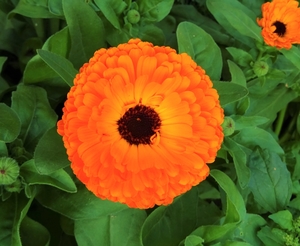
|
Pot marigold |
2-11
Full sun, Partial sun/shade
Moist
Light (sandy), Medium, Heavy (clay)
5.5-7.0
0.6
0.3
Annual
Medium
15cm
6-14 days
21°c (70°f)
60
Compost, Cosmetic, Dye, Essential Oil, Weather forecasting, Dynamic accumulator, Fragrance
Flowers, Leaves
Calendula, Common marigold, Scotch marigold, Ruddles
Ringelblume
Asteraceae or compositae
Spain
Afghanistan, Albania, Argentina Northeast, Argentina Northwest, Argentina South, Assam, Austria, Azores, Baleares, Baltic States, Belarus, Belgium, Bolivia, Borneo, British Columbia, Bulgaria, California, Canary Is., Central European Rus, Chatham Is., Chile Central, Chile North, Chile South, China North-Central, China South-Central, China Southeast, Colombia, Connecticut, Cook Is., Corse, Costa Rica, Cyprus, Czechoslovakia, East Aegean Is., East European Russia, East Himalaya, Ecuador, Ethiopia, France, Germany, Great Britain, Greece, Guatemala, Hainan, Honduras, Hungary, India, Iraq, Ireland, Italy, Jawa, Juan Fernández Is., Kazakhstan, Kriti, Krym, Lebanon-Syria, Lesser Sunda Is., Libya, Madeira, Maine, Malaya, Manchuria, Massachusetts, Mauritius, Mexico Southeast, Michigan, Morocco, Myanmar, Nepal, Netherlands, New Hampshire, New South Wales, New York, New Zealand North, New Zealand South, Newfoundland, North Caucasus, North European Russi, Northern Territory, Northwest European R, Norway, Nova Scotia, Ohio, Ontario, Pakistan, Paraguay, Pennsylvania, Peru, Philippines, Poland, Portugal, Primorye, Qinghai, Queensland, Québec, Romania, Sardegna, Sicilia, South Australia, South European Russi, Sulawesi, Sumatera, Sweden, Switzerland, Tadzhikistan, Taiwan, Tasmania, Tibet, Transcaucasus, Trinidad-Tobago, Turkey, Turkmenistan, Ukraine, Uruguay, Uzbekistan, Victoria, Vietnam, Washington, Western Australia, Wisconsin, Xinjiang, Yugoslavia
https://en.wikipedia.org/wiki/Calendula_officinalis
https://pfaf.org/User/Plant.aspx?LatinName=Calendula officinalis
https://powo.science.kew.org/taxon/urn:lsid:ipni.org:names:187894-1
4.6
Colouring, Tea
true
|
The pot marigold, also known as Calendula officinalis, is a flowering plant probably native to southwestern Asia, western Europe, and the Mediterranean region, however, its long cultivation history makes its precise origin unknown. It is a herbaceous annual plant that typically grows to be about 12-18 inches tall, with hairy stems and leaves. The leaves are lance-shaped, with a hairy surface, and the flowers can range in colour from white through yellow and orange to red and even pink. In terms of growing conditions, the pot marigold prefers well-drained soil and full sun, although it can tolerate partial shade. It is winter hardy, but may not flower as profusely in colder climates. To cultivate it successfully, a grower should plant pot marigold seeds directly in the ground after the last frost of the season. The pot marigold has a number of uses, both culinary and medicinal. The flowers are edible and can be used to add color and flavor to salads and other dishes. The petals can also be dried and used to make tea. In terms of medicinal uses, the plant has been used for centuries to treat a variety of ailments, including wounds, infections, and skin irritation. The pot marigold is also attractive to a variety of pollinators, making it a valuable plant for attracting beneficial insects to the garden. Overall, the pot marigold is a versatile and easy-to-grow plant that is well-suited to a variety of garden settings. ### Propagation - Direct sow Direct sow in spring when light frost is still possible. Can be sown until early summer for fall blooms. ### Propagation - Transplant Sow indoors in late winter, transplant outside when risk of heavy frost has passed. #### Links [Calendula @ West Coast Seeds](https://www.westcoastseeds.com/products/zeolights-organic) |
Show
Edit |
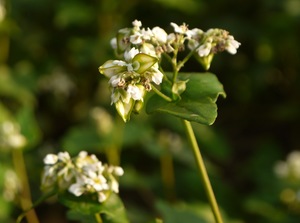
|
Fagopyrum esculentum |
6-12
Full sun
Dry, Moist
Light (sandy), Medium, Heavy (clay)
1.5
0.2
Annual
Fast
true
Leaves, Seed
Brank, buchweizen, chutia lofa, daran, dayat, dhemsi sak, doron, fagopiro, grano saraceno, kotu, kyoubaku, memil, notch-seeded buckwheat, obul, oogal, phaphar, phaphara, phaphra, qiao mai, saracen, sarrasin, soba, tian qiao mai, titaphapur, trigo-sarraceno, alforfón, blé noir, bouquette, bovete, buchweizen, buckwheat, buckwheat herb, common buckwheat, echter buchweizen, faggina, fagopiro, fagopyri herba, fagopyrum, fagopyrum esculentum, grano saraceno, grano saroceno, grano sarraceno, grano turco, grecicha kul'turnaja, grecicha posevnaja, heidekorn, japanese buckwheat, memil, qiao mai, renouée, sa, sarasin, sarrasin, serrasin
Echter buchweizen
Polygonaceae
China South-Central, Tibet
Alabama, Alaska, Albania, Alberta, Altay, Amur, Arizona, Assam, Austria, Bahamas, Baleares, Baltic States, Bangladesh, Belarus, Belgium, Bermuda, Bolivia, Botswana, Bulgaria, Buryatiya, California, Cape Provinces, Central European Rus, China North-Central, China Southeast, Chita, Colorado, Connecticut, Corse, Costa Rica, Czechoslovakia, Delaware, Denmark, District of Columbia, East European Russia, East Himalaya, Ethiopia, Finland, Florida, France, Free State, Georgia, Germany, Great Britain, Hungary, Iceland, Idaho, Illinois, Indiana, Inner Mongolia, Iowa, Iraq, Irkutsk, Italy, Jamaica, Japan, Kamchatka, Kansas, Kazakhstan, Kentucky, Kenya, Khabarovsk, Korea, Krasnoyarsk, Krym, KwaZulu-Natal, Louisiana, Magadan, Maine, Manchuria, Manitoba, Maryland, Massachusetts, Michigan, Minnesota, Missouri, Mongolia, Montana, Mozambique, Nebraska, Nepal, Netherlands, New Hampshire, New Jersey, New Mexico, New York, New Zealand North, New Zealand South, Newfoundland, North Carolina, North Caucasus, North Dakota, Northern Provinces, Northwest European R, Norway, Nova Scotia, Ohio, Oklahoma, Ontario, Oregon, Pakistan, Pennsylvania, Poland, Portugal, Primorye, Prince Edward I., Québec, Rhode I., Romania, Sakhalin, Sardegna, Saskatchewan, Sicilia, South Carolina, South Dakota, South European Russi, Spain, Sweden, Switzerland, Tanzania, Tennessee, Texas, Transcaucasus, Turkey, Tuva, Uganda, Ukraine, Uzbekistan, Vermont, Vietnam, Virginia, Washington, West Himalaya, West Siberia, West Virginia, Wisconsin, Wyoming, Yakutskiya, Yugoslavia, Yukon, Zambia, Zaïre, Zimbabwe
https://en.wikipedia.org/wiki/Buckwheat
https://pfaf.org/User/Plant.aspx?LatinName=Fagopyrum esculentum
https://powo.science.kew.org/taxon/urn:lsid:ipni.org:names:694526-1
Rutin
Dye, Cover crop, Soil reclamation, Dynamic accumulator, Fragrance
|
Buckwheat (Fagopyrum esculentum) is a type of flowering plant that is native to the Himalayas and other parts of Asia. It belongs to the family Polygonaceae, which includes around 120 species of plants. Buckwheat is a popular crop, known for its triangular, reddish-brown seeds, which are used to make flour and other products. The plant has a bushy growth habit and can reach a height of up to 2-3 feet. The leaves are green, heart-shaped, and have a waxy texture, and the flowers are small and white or pink in color. To grow buckwheat successfully, it is important to choose a location with well-drained, fertile soil and full sun. The plant is tolerant of a wide range of soil conditions, but prefers moist, slightly acidic soil. Buckwheat can also be grown in containers, and will benefit from regular fertilization. The plant is relatively easy to grow and requires little maintenance, but can be susceptible to pests and diseases, such as aphids and rust. Buckwheat is a valuable source of protein and other nutrients, and is used in a variety of dishes, including pancakes, noodles, and porridge. The seeds can also be sprouted and added to salads and other dishes. In addition to its culinary uses, buckwheat has a number of medicinal properties, and has been used to treat a variety of ailments, including asthma, allergies, and skin |
Show
Edit |